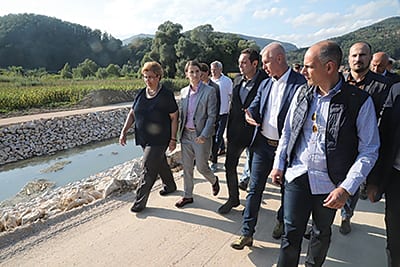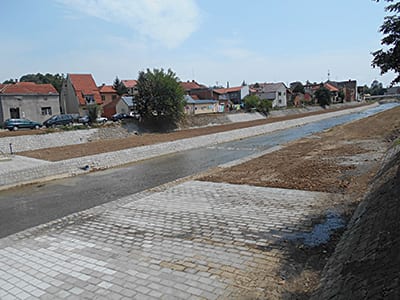Serbia was hit by catastrophic floods in May 2014 that jeopardised human lives, destroyed numerous infrastructure facilities, flooded towns and municipalities, caused damage costing over €1.5 billion and halted the country’s economic growth
The budget for 2018 is higher than the budget of the previous year. The flood protection system consists of over 2,500 kilometers of embankments and riverbank reinforcements, 3,500 kilometres of canal networks, 42 high dams and reservoirs, 65 pumping stations and many other facilities
In this devastating wave of floods, water management facilities were also severely damaged. Immediately after the floods abated, the Government of the Republic of Serbia, led by Aleksandar Vučić, initiated the reconstruction of the country.
Recovery efforts initiated the rehabilitation of destroyed and damaged embankments, regulating structures, pumping stations and other facilities.
Which activities were undertaken to avoid the consequences of major floods like that of 2014?
– Works were undertaken on over 300 sites in 95 municipalities and cities, worth a total amount of 3.5 billion dinars. In parallel with these activities of Public Water Company ‘Srbijavode’, work was also actively undertaken on raising the level of protection with the preparing of technical documentation for the reconstruction of existing facilities and the construction of new ones. A loan from the World Bank was used to build six facilities, while IPA funds are currently enabling the construction of four capital facilities with a total value of €25 million.
In your opinion, which regions remain in the focus of special attention when it comes to possible flooding caused by burst riverbanks?
– It would be good for us to have a peaceful year in a hydrological sense. But at the beginning of March, we already had a flood wave in the river basin of the South Morava and Timok, due to the sudden melting of snow. What is worrying is information that amounts of snow, primarily in the Alps, are at their highest since 2006, and that year we had to endure a long and difficult defence of the Danube and Sava.
There are also still large amounts of snow in the Sava River Basin in Slovenia, Croatia and Bosnia, as well as in the Carpathian region. All of this indicates that the situation in April and May will not be easy and that we can expect high water levels along these rivers. The basins of the West and South Morava rivers, the Kolubara, Drina and Timok, must also be given special attention.
Where are works being carried out today on facilities that will prevent floods and damage to both buildings and arable land?
– We today have active 75 construction sites in 45 cities and municipalities (Kraljevo, Vrnjačka Banja, Lučani, Leskovac, Vlasotinci, Lebane, Koceljeva, Smederevska Palanka etc.), where works are being carried out and the level of flood protection is being increased. The value of these works is 1.7 billion dinars. I would like to emphasise that last autumn we completed construction of the embankment and pumping station in Lučani, with which the settlement, industrial zone and arms industry facilities are protected, and that today we are conducting works on the other bank of the Bjelica, in order to protect the settlement of Đerađ.
The public should know that the degree of flood protection differs for towns, settlements, energy and other infrastructure facilities and agricultural areas. This means that agricultural areas are protected with the lowest level of protection. If every field or meadow were to be defended, that water would more quickly reach cities and other vital systems located beside rivers, and the defending against floods would be impossible with incalculable consequences.
How much progress has been made on the reconstruction of the Parmenac-Katrga Canal and what will agriculture gain with the culmination of this project?
– This year it is planned to start the reconstruction of the first six kilometres from Parmenac and enable irrigation of several hundred hectares of agricultural land in that part. With the leadership of the City of Čačak, plans are being harmonised for downstream sections, because of the conditions on the terrain change with the passing of the road corridor to the Morava valley.
The Kolubara River Basin is one of the most threatened in Serbia. What kind of plans are there for the protection of Valjevo, Ub, Obrenovac and other settlements, energy facilities and other structures?
– In May 2014, the Kolubara River demolished infrastructure completely and caused immeasurable adverse effects in all parts of its catchment area. We are in the final phase of developing a study on protection against harmful effects of the River Kolubara, and that study represents a comprehensive basis for everything to be planned and built in the next 20-25 years.
The development of preliminary designs for the construction of two reservoirs above Ub and Koceljeva, ’Pambukovica’ and ’Kamenica’, is underway, with the beginning of their construction expected by the end of next year. Project tasks for the project to reconstruct 32 kilometres of embankments beside the Kolubara are being prepared. Here we are confronted by a few key problems that condition very long deadlines, both for design and construction. These primarily related to a lack of planning documentation and the difficulty of resolving property relations on the ground.
Compared to previous years, how much is allocated to Srbijavode from the budget today, and are these resources sufficient for flood protection needs?
– The Serbian Government has recognised this problem. The budget for 2018 is higher than the budget of the previous year. The flood protection system consists of over 2,500 kilometres of embankments and riverbank reinforcements, 3,500 kilometres of canal networks, 42 high dams and reservoirs, 65 pumping stations and many other facilities. From year to year, the Republic of Serbia is increasing its allocations for water management.
The allocated funds this year represent about 65% of the funds required for regular maintenance of the constructed facilities. The basic problem is an insufficient investment in the water management system in the past three decades. As a consequence, we have devastated facilities and today we aren’t talking about regular maintenance, but primarily about remediation or reconstructions of water facilities. That’s why we expect even stronger financial and legal support.
Serbia is one of the world’s countries that has great water resources. How can we protect this resource in the long term, given that water will soon be among the most sought-after resources?
– This kind of thinking creates problems and shapes our relationship towards the water. Serbia is a country that, spatially and temporally, does not have good distribution. There are parts of the country where we do not have enough water or where it is of poor quality, for example in Vojvodina.

On the other hand, in some parts of our country, there are periods during the year, primarily in spring, when there is more water than necessary and during the summer or autumn, we don’t have enough drinking water, not to mention water needed for industry and agriculture. Those are the valleys of Toplice, Pčinja, South Morava, Mlava etc.
We need to change our relationship with water systematically. Energy-efficient use of all water sources, reduction on pollution of surface waters, forestation, raising ecological awareness among our citizens, educating children from preschool to higher education institutions – these are just some of the measures that, if implemented systematically, can yield results in the long term.
What can Srbijavode do within the framework of its existing budget when it comes to maintaining watercourses and building riverbank reinforcements and other facilities, and what are your plans for the period ahead?
– Srbijavode has three priority tasks in the next four years.
Firstly, within the framework of the current budget, to determine priority areas and facilities where the available resources can ensure the achieving of maximum protection; for the regular maintenance of facilities to reach the required level and to halt the further destruction of water facilities and the entire water management system.
Secondly, to prepare projects for the new investment cycle as soon as possible, define maps of blue zones, establish an early warning system and define the full coordination of all stakeholders at the state and local government levels.
Thirdly is the implementation of reforms of Srbijavode itself, strengthening staffing, improving and using of new IT solutions; the preparation of a new law on water and law on financing, in line with European water directives, as well as raising transparency in work and strengthening ties with international investment institutions. The path of one drop of rain from cloud to spring lasts several hundred or thousand years.